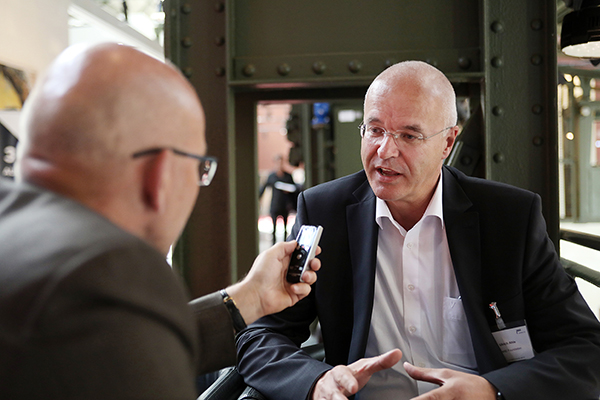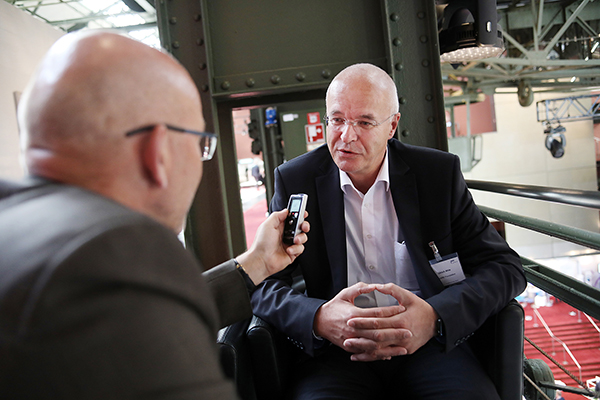The FIWARE IoT platform is Open Source and Open API
An interview with Ulrich Ahle
Even though the FIWARE Foundation already has 100 members, it is still not widely known in Germany. Changing this situation will be one of the tasks of Ulrich Ahle, who has been active as the Foundation's CEO since the beginning of the year. However, his main role is to drive forward the development of new services based on the FIWARE open-source platform. In this interview, the former ATOS spokesman explains his new mission.
Question: Mr Ahle, although the FIWARE Foundation was set up in the fall of last year, its history actually goes back rather longer than that. What were the origins?
Ahle: FIWARE's origins go back five years to the time when the European Commission launched a Future Internet Private Public Partnership (FI PPP) with the aim of creating an open-source IoT platform. Over the last five years, around 300 million euros were invested in expanding this platform, this not only involved developing the platform itself but also creating an open standard for data exchange. NGSI (Next Generation Service Interface) makes it possible to exchange data in the Internet of Things and in the field of smart services.
Question: How many companies have taken part in this partnership?
Ahle: FI PPP has seen various programs and been through a number of different phases. However, if we consider the entire period, more than 1,000 companies across the whole of Europe have been supported. A large number of new start-ups have emerged that are today still part of the FIWARE community and are continuing to develop this open source software.
Question: So why was the FIWARE Foundation brought to life?
Ahle: When the third funding phase came to an end last year, the commission initiated the development of the Foundation to ensure the long-term sustainability of the investments made. It was founded by ATOS, the Italian IT service provider Engineering, Orange and Telefonica, but it also welcomes other companies. For example, a few months ago, the Japanese NEC Corp became the Foundation's fifth Platinum member. As early as the second FIWARE Summit at the end of May, the Canadian OPAF became the Foundation's 100th member.
Question: What are the Foundation's objectives, what is it intended to achieve?
Ahle: The blueprint behind the FIWARE Foundation is similar to that of OpenStack or the Linux Foundation. One of our tasks is to coordinate the community, including organizing events such as the FIWARE Summit that took place at the end of May in Utrecht. The second task is to use FIWARE technology to help start-ups develop a viable business model that will enable them to survive in the future even without funding. Thirdly, we also want to address new branches of industry. FIWARE grew up in the "smart cities" environment as a platform for the digitalization of cities and municipalities. We want to develop this approach in the direction of smart agri-food, i.e. the digitalization of agriculture and food production, as well as in the direction of smart industry, including Industry 4.0. The fourth and final task is globalize what has been developed in Europe because this type of IoT approach cannot thrive in the long term unless it is globally accepted and adapted.
Question: What types of start-up have emerged in the FIWARE environment?
Ahle: They are companies that create applications using the FIWARE modules. For example, one company collects sensor data that monitors the air quality in cities and municipalities; others permit intelligent street lighting or equip street lamps with cameras and sensors to identify free parking spaces and report these to navigation systems. These solutions do not necessarily have to be open source because ultimately, at some point, you also have to make money.
Question: Further development of the IoT platform also costs money. But isn't the FIWARE Foundation a non-profit organization?
Ahle: That is correct. However, we don’t develop any software ourselves but instead manage development using agile methods. The resources come from the community, which includes a number of large companies as well as many smaller start-ups and freelancers that cooperate within it.
Question: How do you enable these start-ups to develop their ideas through to market maturity?
Ahle: To do this, we have two programs that we call FIWARE Accelerators and encourage companies that have initial solution concepts to submit their suggestions. Twenty-four of these companies then each receive 100,000 euros, which they do not have to pay back, to bring their solutions to the market. The best four of these then receive a further 250,000 euros and the best two a further 1.5 million euros of venture capital. The other grants are financed by funding from the European Commission. Over 900 start-ups have applied for this attractive funding.
Question: Do the cities that are to be made smart also contribute to the funding?
Ahle: Not to these programs but in other ways. There is the Open & Agile Smart Cities Initiative, a federation of cities that have undertaken to drive their digitalization forward on the basis of FIWARE. The initiative currently includes 109 cities from 22 countries, although not yet any German cities. In my opinion, we in Germany are still lagging somewhat behind in terms of digitalizing cities. Other European countries are more advanced in this field. Malaga, for example, operates its own FIWARE data center and has set up a so-called iHUB where people can gain experience with FIWARE and discuss related topics.
Question: FIWARE has proved to be quite a success story. Why have people from outside the IoT community so far not heard anything about it?
Ahle: In some parts of Europe, even members of the community have not heard much about it. This has something to do with the fact that FIWARE has historically been very focused on southern Europe. Even ATOS was originally involved through ATOS Research & Innovation in Spain. When the decision was taken to transfer the Foundation's headquarters to Berlin, our CEO asked me if I might like to throw my hat into the ring. That was the first time that I had heard of FIWARE even though I am fairly familiar with the IoT environment.
Question: You want to expand geographically and also address new markets such as smart industry. What about smart engineering?
Ahle: With smart industry, we are addressing both manufacturing and product engineering, although I have to admit that we do not as yet have such a broad-based presence in the latter field. As far as globalization is concerned, we are delighted that NEC has decided to join us because this will help FIWARE develop a much higher profile in Japan. NEC has already made its first commercial offers based on FIWARE, e.g. the smart city in Wellington, New Zealand. If we look to the west then it seems that the American standardization agency NIST has accepted FIWARE. There is also a White House initiative to invest 80 million dollars in smart cities for which FIWARE, among other solutions, has been recommended as the basis.
Question: What distinguishes FIWARE from other IoT platforms? After all, it is not the only platform, and not even the only open-source platform?
Ahle: At the moment, there are a good 360 IoT platforms around the world and approximately 10 of these are open-source applications. What makes us different is that we provide not only the platform but also the data exchange standard with which we want to implement a concept that we call multi-sided markets. The starting point for this is the idea that data does not necessarily reveal all its benefits in the field where they are generated but possibly in a very different context. With our standard, we can bring together data from different areas of application within a single platform. Another distinguishing feature is our FIWARE Enablers, which make it possible to put applications together very quickly. This has also been confirmed by the Fraunhofer Institute for Open Communication Systems (FOKUS), which was asked to analyze the robustness and scalability of the software architecture before the Foundation was set up. With very positive results.
Question: Can the standard also be used to connect FIWARE to other IoT platforms?
Ahle: The topic of connectivity is another distinguishing feature. We are not just open source, but also open API. Which gives rise to our motto: Open APIs for Open Minds. We are therefore open at the level of interfaces and data models. As you know, I’m also a member of the board of the Industrial Data Space Association, whose approach is to connect different IoT platforms in order to create shared, virtual data spaces. We are currently working on the first open-source implementation of the IDS concepts on the basis of FIWARE.
Question: How many IoT platforms does the world need?
Ahle: In an ideal world, just one. But that will never happen. There will continue to be competition and there may very well also be situations in which it makes sense for companies to choose a proprietary platform, for example because the components can be integrated particularly effectively. However, I venture to doubt that we need 360 platforms, and the number is continuing to grow. I am firmly believe that we will see some streamlining of the market in this area.
Mr Ahle, thank you very much for this interview. We wish you every success with the FIWARE Foundation. (The interview was conducted by Michael Wendenburg)
About the interviewee
Ulrich Ahle (born 1962) has been head of the Berlin-based FIWARE Foundation since the start of the year. Prior to this, he worked for the IT service provider ATOS, one of the Foundation's four founding members, where he was responsible for the consulting and systems integration business in Germany for customers in the manufacturing, retail and transportation industries. Ahle trained as a toolmaker and studied mechanical engineering at Paderborn University before launching his career at Nixdorf Computer AG. From 1996 to 2002, he held a number of different management positions at Siemens Business Services, his last as head of sales for Siemens IT Solutions and Services. Ahle has been a member of the prostep ivip Association’s board for over 15 years and since 2016 has also been a member of the board of the Industrial Data Space Association.
|




